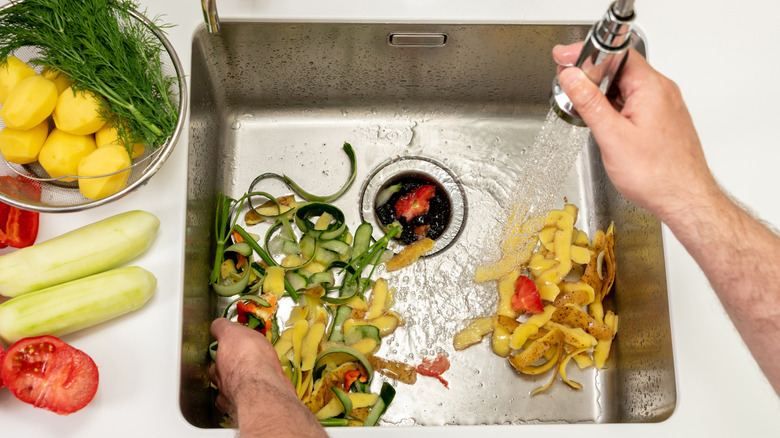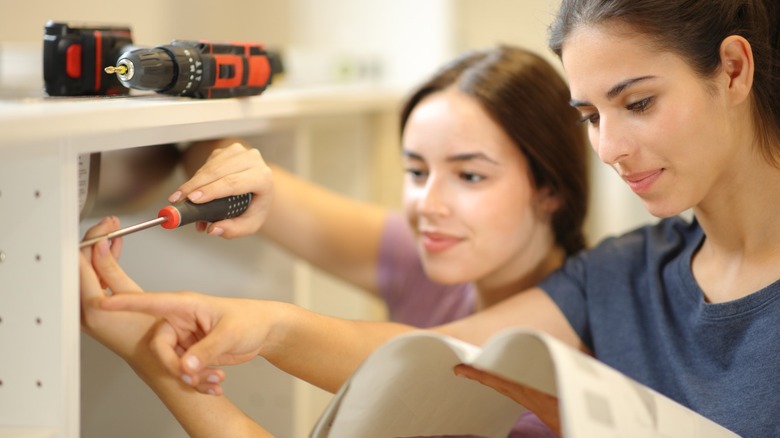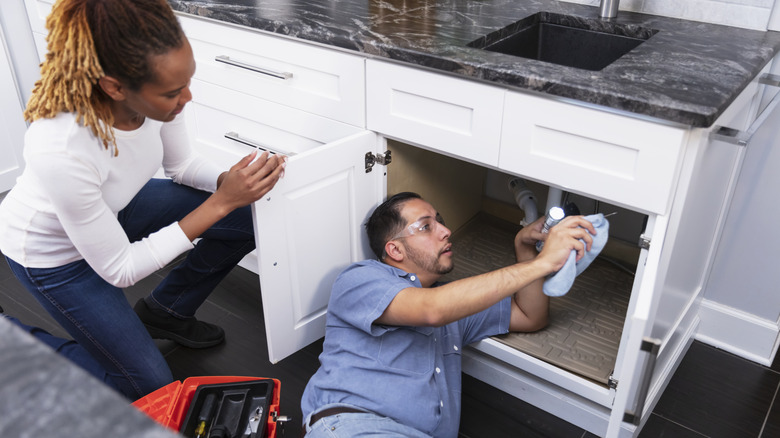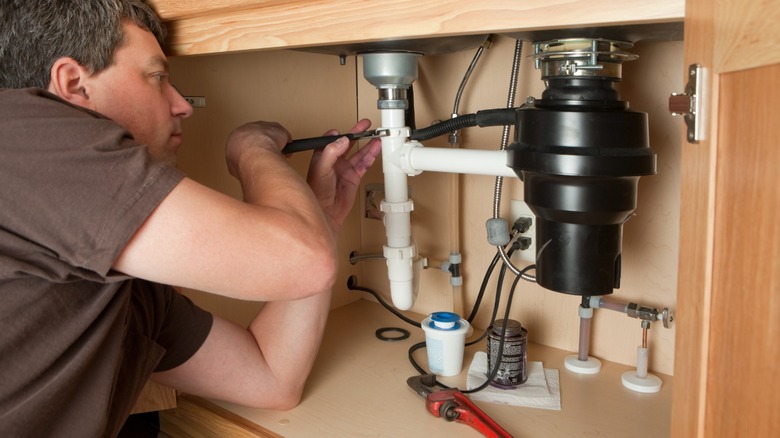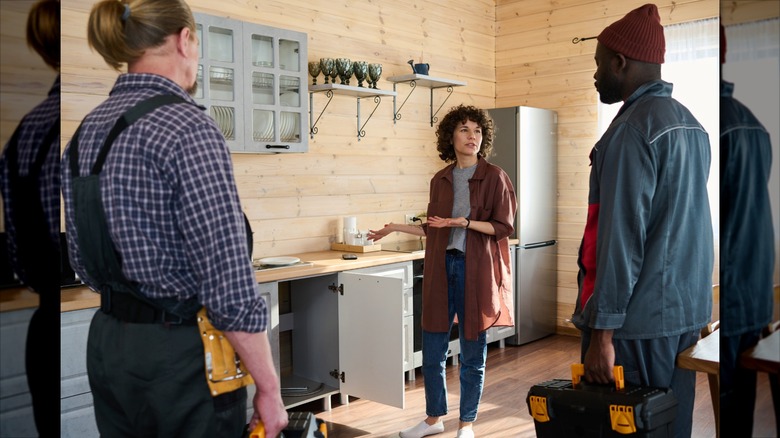How To Install A Garbage Disposal Without Help From The Pros
We may receive a commission on purchases made from links.
A garbage disposal makes short work of food scraps. Installing the small but powerful device beneath your kitchen sink helps to keep stinky food out of your trash can by grinding it into tiny pieces that can easily pass through your pipes into sewer or septic systems. There are important things to consider before installing a garbage disposal, like the state of your plumbing, the available space under your sink, and which model provides the ideal performance. But should you install a garbage disposal without help from the pros? To find out, we spoke with Frontdoor's Virtual Plumbing Expert, Eddie Linares, who says it can be a great DIY project that saves you money.
"With the right tools, a bit of patience, and careful attention to detail, you can have your new disposal unit installed and working in no time," Linares told House Digest in an exclusive interview. Along with purchasing a garbage disposal unit, the plumbing expert says you'll need several tools to complete the installation. Before getting started, grab an adjustable wrench, a pipe wrench, and a pair of channel lock pliers. You will also need some plumber's putty, plumber's tape, and a bucket or container to catch water. And, since working under a sink can be dark, make sure you have a flashlight like the Ryobi Cordless Flexible Clamp Light nearby.
Do your research and enlist a helper before you get started
If you're looking for budget-friendly kitchen upgrades that don't involve remodeling, this project is a good one. "Installing a garbage disposal can be an easy and rewarding DIY project with some planning and care," Eddie Linares said during his exclusive interview with House Digest. Because the installation process involves both plumbing and power, if you're going to install a garbage disposal without help from a professional, make sure to do your research. It's not just about picking out the right garbage disposal unit, but about understanding the systems that make it work.
"Each disposal unit is different, so thoroughly read the user manual before beginning the installation," Linares advised. He also said it's important to use the right size disposal. "Ensure the new disposal unit is compatible with your sink and drain size. If you're replacing an old unit, consider buying a similar size for a smoother installation," Linares suggested.
Along with having a helper nearby, especially if your new garbage disposal is heavy or bulky, the plumbing expert says it's important not to rush the process. "Take your time with each step to avoid making mistakes," he cautioned. "Double-check your work as you go, and don't skip any steps, even if you feel confident," Linares added. You may also want to consider temporarily removing cabinet doors to give yourself more room to work.
Turn off the water and power before preparing the mounting assembly
Installing a garbage disposal is a two part process: preparing the mounting assembly and connecting the new unit. Before starting, it's critical that you completely shut off the water supply to your home. "Place a bucket underneath the sink to catch leftover water in the pipes while you work," Eddie Linares suggested during our exclusive interview. "For safety, ensure that the garbage disposal's power is turned off," he added. The plumbing expert said you'll either need to unplug the existing disposal from an electrical outlet under the sink or turn off the power from your breaker box if it's hardwired.
Next, you'll need to remove the old disposal (if you have one). "Disconnect it from the drain pipe and remove the mounting bolts," Linares said. "Use the pipe wrench to loosen the drain flange and any plumbing connections," he added. Consider recycling your old garbage disposal at a local collection center that accepts metal items. Then it's time to prepare the sink mounting assembly.
According to Linares, "The assembly typically includes a mounting ring, a flange, and a gasket." He told us you'll need to apply plumber's putty around the flange, which is the part that connects to the sink. "Place the flange in the sink drain hole, press down to ensure it's secure, and wipe away any excess putty," the plumbing expert advised. Finally, you'll attach the mounting bracket to the flange using the included screws.
Carefully connect the garbage disposal before testing for leaks
Once your flange and mounting assembly are firmly in place, it's time to install the garbage disposal itself. Plumbing expert Eddie Linares told us each model connects differently to its mounting bracket, so it's important to carefully read the instruction manual for your specific unit. He advised that you "lift the garbage disposal under the sink and line it up with the mounting bracket. Once aligned, twist the disposal unit into place to lock it securely." Linares said some models may use additional screws or bolts to hold your garbage disposal in position. Make sure to install those prior to moving on to the next step.
Then, connect your garbage disposal to the existing plumbing. "Attach the discharge tube (the drainpipe leading from the disposal) to the disposal's drain outlet," Linares explained. "Tighten the connections with a pipe wrench," he added. The expert uses plumber's tape like the bestselling VOTMELL Teflon Sealant Tape on threaded connections to prevent leaks.
Next, make your electrical connections. "If the unit has a plug-in electrical cord, simply plug it into the outlet under the sink," Linares said. "If your unit is hardwired, you must connect the disposal to the power wires following the manufacturer's instructions," he explained, while cautioning that you must wire your garbage disposal correctly to avoid any short circuits. Test for leaks by turning on the water and checking each connection. "Once you're confident everything is leak-free, plug the disposal in and test it by running water through it," Linares advised.
Know when it's time to call in a licensed plumber or electrician
While there are some home improvement projects that are better left to the professionals, installing a garbage disposal yourself is possible. In his exclusive interview with House Digest, Eddie Linares said there are some common mistakes you should know how to fix. Not using enough plumber's putty, forgetting to use a dishwasher drain connection, and overtightening connections are among them. "Plumber's putty ensures a watertight seal between the disposal and the sink," Linares reminded us. "Leaks can go unnoticed until they cause severe water damage, so check all connections, especially where the disposal attaches to the sink and the plumbing," he added.
Linares also warned that incorrect wiring can cause major problems. "One of the most common mistakes is wiring the disposal incorrectly," he cautioned. "If your disposal is hardwired, match the wires to the correct terminals (typically black to black, white to white, and green to the ground)," Linares advised. If you're unsure about wiring, the plumbing expert said it's time to call a licensed electrician.
You may also need to enlist the help of a pro if you encounter significant plumbing issues. "If your sink's drain pipe for plumbing is old or damaged, it might need to be repaired or replaced before you can properly install the new disposal," Linares told us. He added that if the new disposal doesn't fit with your existing plumbing configuration or if you encounter a persistent leak after installing a garbage disposal yourself, a plumber will likely be the fastest way to diagnose and fix the issue.
